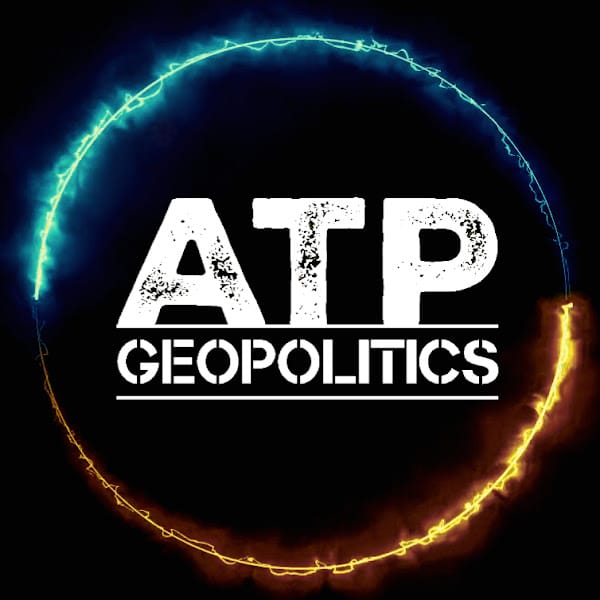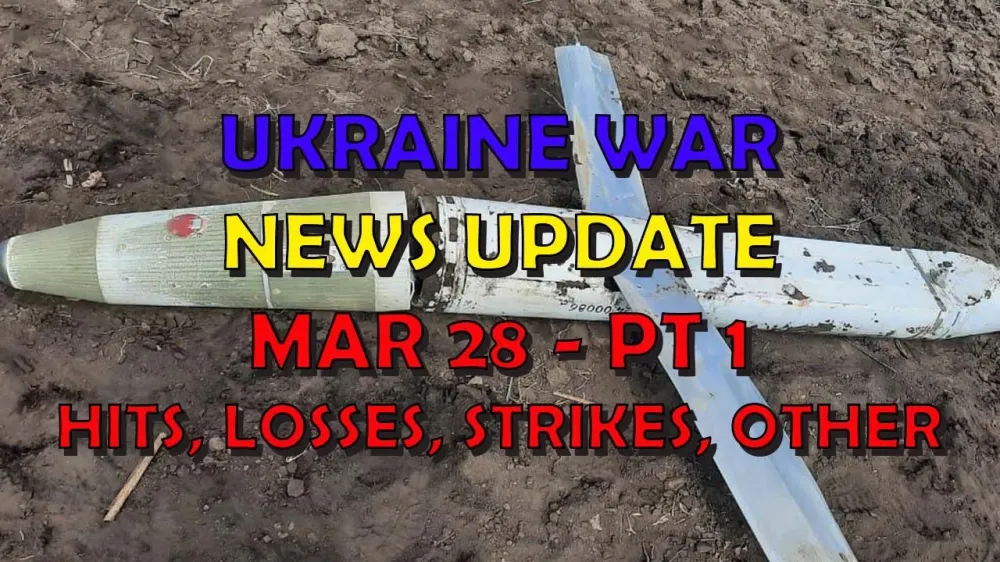Ukraine War Update NEWS: Pt 1 - Overnight & Other News
Table of Contents 📖
"Why doesn't that get played to Marjorie Taylor Greene? Why doesn't this stuff get played to Jackson Hinkle? Why doesn't this stuff get into the information spaces? Why is it not played more overtly on CNN, on Fox News? That would be nice. This is what Russians are really saying and this is why it is morally incumbent upon, morally obligatory for the US or for any nation with a moral backbone to support Ukraine - this is who the bad guys are."
Hello Team
🎦 00:00-00:25⏩
Jonathan welcomes viewers to a slightly shorter Ukraine War news update. He predicts it will be shorter than recent videos which have been around 45 minutes long.
Return to top⤴️
🪦 DISCLAIMER FOR GENERAL STAFF LOSSES DATA
- These are real people with real lives and real families who love them. Don’t let the numbers sap your humanity.
- These numbers probably aren’t accurate but they’re the best we have and we don’t need them to be accurate to be indicative of patterns of activity.
- All losses are estimates. Losses cannot be counted with accuracy because of the conditions on the ground.
- Both sides would see it to be of their advantage to minimize their own losses maximize the other side’s losses.
- Neither side releases their losses but we have enough transparency from the Ukrainian side to have confidence in they are indicative.
- Personnel losses are hard to count. If a soldier gets injured, heals up, and returns to the front line only to get injured again, is that one loss or two? Also, how to deal with losses from PMC’s or soldiers fighting with RF from occupied territories?
- Equipment losses are hard to count. If an AA complex involves several parts and one part gets disabled, is that a loss, or a fraction of a loss? If a tank gets disabled, repaired, back into the fight, then disabled again, is that one lost tank or two?
- All recorded losses are vulnerable to multiple reporting. We have already seen numerous cases of multiple drones in the air reporting the same loss from different angles as multiple engagements.
- Losses are not always reported on the same day they occurred. It is frequent that drone losses are reported at least 24 hours after other terrestrial equipment losses. Certain losses may not be reported for days or weeks for military intelligence reasons.
Russian Losses
🎦 00:25-01:55⏩
Jonathan reviews the Ukrainian General Staff's figures for estimated Russian losses from the previous day:
- 780 personnel (lower end of the average for recent weeks but above the average for the entire war)
- 10 tanks (significant loss for a single day)
- 21 armoured personnel vehicles
- 32 artillery systems
- 2 multiple launch rocket systems
- 1 anti-aircraft warfare system
- 56 vehicles and fuel tanks
- 6 pieces of special equipment
He notes that while personnel losses are not the highest, the equipment losses are significant.
Return to top⤴️
Russian Soldier Testimony
🎦 01:55-04:16⏩
Jonathan discusses a video shared by Tim White and Anton Gerashchenko of surviving members of the Redoot PMC, a veteran unit. Key points:
- Out of 230 soldiers who began, only 38 remain.
- The soldiers report difficulties receiving combat pay and veteran status.
- They were promised 195,000 rubles per month but received only 40,500.
- Some soldiers have had contracts extended without their consent or their families being informed.
Jonathan highlights the catastrophic personnel losses and the Russian government's failure to properly compensate its soldiers.
Return to top⤴️
Miscellaneous Footage
🎦 04:16-06:05⏩
Jonathan briefly mentions other footage circulating online:
- A destroyed Russian truck with an anti-submarine missile launcher mounted on the back.
- A video from "Magiar's Birds" showing a Russian boat in the Dnipro river delta hitting one of its own mines while laying mines.
Standoff Munitions and Overnight Drone Attacks
🎦 06:05-06:58⏩
Jonathan reports that Ukraine shot down 26 out of 28 Russian kamikaze drones launched overnight, demonstrating continued success in intercepting drones. However, Russia also used missiles that are harder for Ukraine to intercept, including:
- 3 Kh-22 cruise missiles
- 1 Kh-31P missile
- S-300 surface-to-air missiles used in ground attack mode
There is no evidence that Ukraine was able to shoot down any of these missiles.
Return to top⤴️
Russian Missile Strike on Kherson State University
🎦 06:58-08:04⏩
Jonathan discusses the Russian ballistic missile strike on Kherson State University. He questions whether the university was a genuine military target, expressing doubt and suggesting that it appears to be an act of terrorism aimed at demoralizing the Ukrainian population. He notes that during his visit to Kherson, he observed only civilians struggling to maintain a semblance of normalcy, making any attack on the city an act of terror in his opinion.
Return to top⤴️
Drone Attack in Zaporizhia
🎦 08:04-08:21⏩
Jonathan reports on a Russian drone attack on transport infrastructure in the Zaporizhia region:
- 11 drones were shot down.
- One drone got through, causing a fire.
- Falling debris injured two people.
Double Strike in Kharkiv
🎦 08:21-09:05⏩
Jonathan reports on a Russian double-tap missile strike in Kharkiv, a tactic where a second strike targets first responders:
- One person was killed in an apartment building.
- Initial reports indicate 10 wounded, with the number expected to rise.
- Four children are among the wounded.
New Russian Glide Bomb Used in Kharkiv
🎦 09:05-11:13⏩
Jonathan discusses Russia's use of a new aerial bomb, the UMPB D30SN, in the attack on Kharkiv. This bomb has a range of up to 90 kilometers, allowing Russian aircraft to strike from a distance, potentially out of range of some Ukrainian air defenses. Key takeaways:
- The youngest victim was three months old.
- The bomb's extended range poses a significant threat to cities like Kharkiv, Sumy, and Zaporizhia.
- Anton Gerashchenko, quoted by Jonathan, stresses the need for at least eight Patriot systems to counter this threat.
- Gerashchenko argues that destroying Russian aircraft before they launch these bombs is crucial, and Patriots are the only systems proven effective against them.
- Without adequate air defense, Gerashchenko fears Kharkiv will meet a fate similar to Mariupol.
Missile Strike on Mykhailivka
🎦 11:13-12:04⏩
Jonathan reports on a missile strike in Mykhailivka that injured 12 people, eight of whom were hospitalized. The strike hit a factory, causing a fire and damaging six nearby apartment buildings. It's unclear whether the factory was a legitimate military target.
Return to top⤴️
Ukrainian Strikes on Belgorod
🎦 12:04-12:34⏩
Jonathan highlights the frequent Ukrainian strikes on Belgorod, a city in Russia near the Ukrainian border. He explains that Belgorod serves as a staging ground for Russian attacks on Kharkiv, hence Ukraine's focus on targeting the city. The strikes are an attempt to disrupt Russian operations and protect Kharkiv.
Return to top⤴️
France's Increased Support for Ukraine
🎦 12:34-14:16⏩
Jonathan discusses France's increasingly assertive stance in support of Ukraine:
- Calls for sending Aster 30 surface-to-air missiles to Ukraine.
- French politicians are prominently featuring Ukraine in their European election campaigns.
- Macron's diplomatic efforts to garner global support for Ukraine, including his recent trip to Brazil, demonstrate a strong commitment to the cause.
- Jonathan commends Macron's leadership, stating he's "doing a damn good job" in supporting Ukraine.
Germany's Response to Criticism of its Support
14:16-15:19⏩
Jonathan acknowledges criticism of Germany for not providing Taurus missiles to Ukraine. However, he defends Germany's contributions, pointing out:
- Germany is spending significant amounts on aiding Ukraine.
- Chancellor Olaf Scholz reiterated his opposition to providing Taurus missiles, citing concerns about escalating the conflict into a NATO-Russia war.
Russian Military Reliant on Inaccurate Pro-Russian Maps
🎦 15:19-20:20⏩
Jonathan delves into Andrew Perpetua's findings on Russian military blunders stemming from their reliance on inaccurate maps created by pro-Russian sources, particularly Syriac maps. Key points:
- Russian soldiers, relying on these maps, are launching attacks on areas they mistakenly believe to be under their control.
- These inaccurate maps are based on information from pro-Russian Telegram channels and not on verified intelligence.
- Jonathan expresses astonishment that Russian units base their operations on online maps instead of relying on real-time intelligence or communication with units on the ground.
- He questions the state of Russian military intelligence and communication if soldiers are resorting to such methods.
- He recounts previous instances, like the botched Dnipro river operation, where similar reliance on flawed maps led to Russian setbacks.
Disinformation and Social Media
🎦 20:20-23:01⏩
Jonathan transitions to a broader discussion about disinformation, using the inaccurate maps as a jumping-off point:
- He argues that social media platforms like Twitter are being exploited to spread pro-Russian disinformation.
- He criticizes accounts like "Syriac map" for disseminating misinformation but avoiding bans.
- He points to pro-Russian figures like Jackson Hinkle, who use Twitter's amplification features (paid blue ticks) to spread propaganda, while those advocating for truth are hesitant to pay for such amplification.
- Jonathan sees this as a calculated strategy by Russia to exploit social media for information warfare, a strategy he finds highly effective.
- He cites an EU report highlighting Twitter as a breeding ground for disinformation due to its ease of manipulation.
US Stance on Ukrainian Strikes in Russia and Allied Dissent
🎦 23:01-27:22⏩
Jonathan addresses a viewer comment from "Tomcat" disagreeing with his stance on the US government's response to Ukrainian strikes on Russian refineries. Key points from the discussion:
- Jonathan clarifies that the US government's public disapproval of such strikes doesn't necessarily mean they oppose them privately.
- He suggests that the US might be distancing itself publicly to avoid feeding into the Russian narrative of a proxy war.
- Jonathan posits that behind closed doors, the US might support these strikes.
- He cites a Financial Times article, based on anonymous sources, as potential evidence.
- He acknowledges "Tomcat's" concerns about narratives of dissent within the Western alliance, agreeing that focusing on productive solutions like utilizing frozen Russian assets would be more beneficial.
- Jonathan acknowledges that focusing on positive actions, like leveraging the $300 billion in frozen Russian assets, is a more productive approach than highlighting internal disagreements.
Russian Propagandists' Extreme Rhetoric
🎦 27:22-28:40⏩
Jonathan concludes by emphasizing the need to recognize the true nature of Russian propaganda:
- He cites Russian propagandist Vladislav Shurigin, who, on state television, called Ukrainians "animals" and advocated for wiping out entire towns with cluster munitions.
- Jonathan questions why such extremist rhetoric isn't given more attention in Western media outlets like CNN or Fox News.
- He argues that this rhetoric exposes the moral bankruptcy of the Russian position, making it a moral imperative for nations to support Ukraine.
Wrap up
🎦 28:40-28:43⏩
Jonathan thanks viewers for watching and expresses his appreciation for their support.
Return to top⤴️




